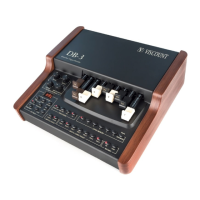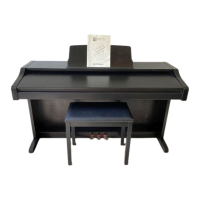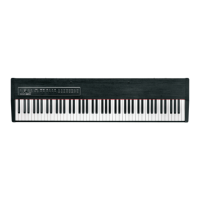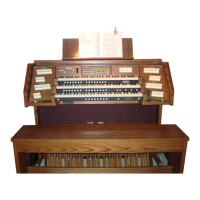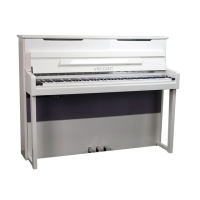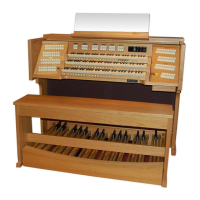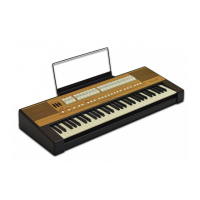Do you have a question about the Viscount Jubilate 230 and is the answer not in the manual?
Warnings regarding electrical shock prevention, including not opening the unit or exposing it to moisture.
Precautions for safe use, including supervision near children and avoiding loud volumes.
Selects one of six memory banks for general and particular memories.
Shifts instrument tuning by semitones for easier playing in different keys.
Chooses historical temperaments to recreate authentic ancient music.
Controls the power state of the Jubilate organ.
Controls for the pedal board on Jubilate 230-235 models.
Controls for the first manual on Jubilate 230-235 models.
Controls for the second manual on Jubilate 230-235 models.
Details on MIDI transmission, reception, and programming features.
Drawstops for the pedal on the Jubilate 245 model.
Drawstops for Man.I on the Jubilate 245 model.
Controls the power state of the Jubilate 245 organ.
Assigns pedal board functions to keys and changes voice styles.
Manages MIDI data transmission for Man.I, Man.II, and Pedal on Jubilate 245.
Enables coupling of manuals and pedal board on Jubilate 245.
Assigns pedal board functions and changes voice styles on Jubilate 245.
Potentiometers for master, manual I, reverb, and pedal volume adjustment.
Selects one of 16 types of Tremolo effect for amplitude and modulation.
Controls for the second manual, including Tremulant and tabs.
Potentiometers for master, manual I, and pedal board volume adjustment.
Controls for shifting tuning and selecting historical temperaments.
Controls for reverb amount and selection of 16 Tremolo effects.
Selects one of six memory banks for storing settings.
Keyboard section for entering MIDI channel or Program Change data.
Buttons for setting, storing, and recalling general and particular memories.
Allows the swell pedal to control the volume of the entire organ.
Buttons for activating chimes sound and the full 'Great Organ' sound.
Turns off all registers or activates registers on another Viscount organ via MIDI.
Six memory locations for each manual and pedalboard on specific models.
Volume pedal for Man.II, can control whole organ if ENC is active.
Pedal controls volume for both the first manual and the pedalboard.
Pedal controls the volume of the second manual; can control whole organ if ENC is active.
Pistons used to switch on couplers as described in chapter 2.
Activates the 'Great Organ' sound, engaging all registers.
Provides +12 Volt tension, typically for remote function activation.
Connects the organ to other MIDI devices for data exchange.
Inverts voices between Man.I and Man.II.
Transmits Program Change data to external MIDI devices.
Activates one of eight classical demo sequences stored in memory.
Recalls pedal memory when a Great manual memory is recalled.
Defines common MIDI terms like Channel, Note On/Off, Program Change, Control Change.
Adjusts the overall tuning of the instrument, factory set to A=440 Hz.
Amplification input for mono or stereo sound sources.
Non-amplified output for connecting to external speakers or recording equipment.
Stereo headphone output; automatically cuts off internal amplification.
Procedure to reset the instrument in case of malfunctioning before calling service.
Disables internal sound generation for selected voices when piloting external MIDI devices.
Details on transmitted and recognized MIDI channel modes and messages.
Information on transmitted and recognized note number and velocity data.
Chart of transmitted and recognized control, program, and system exclusive messages.
Warnings regarding electrical shock prevention, including not opening the unit or exposing it to moisture.
Precautions for safe use, including supervision near children and avoiding loud volumes.
Selects one of six memory banks for general and particular memories.
Shifts instrument tuning by semitones for easier playing in different keys.
Chooses historical temperaments to recreate authentic ancient music.
Controls the power state of the Jubilate organ.
Controls for the pedal board on Jubilate 230-235 models.
Controls for the first manual on Jubilate 230-235 models.
Controls for the second manual on Jubilate 230-235 models.
Details on MIDI transmission, reception, and programming features.
Drawstops for the pedal on the Jubilate 245 model.
Drawstops for Man.I on the Jubilate 245 model.
Controls the power state of the Jubilate 245 organ.
Assigns pedal board functions to keys and changes voice styles.
Manages MIDI data transmission for Man.I, Man.II, and Pedal on Jubilate 245.
Enables coupling of manuals and pedal board on Jubilate 245.
Assigns pedal board functions and changes voice styles on Jubilate 245.
Potentiometers for master, manual I, reverb, and pedal volume adjustment.
Selects one of 16 types of Tremolo effect for amplitude and modulation.
Controls for the second manual, including Tremulant and tabs.
Potentiometers for master, manual I, and pedal board volume adjustment.
Controls for shifting tuning and selecting historical temperaments.
Controls for reverb amount and selection of 16 Tremolo effects.
Selects one of six memory banks for storing settings.
Keyboard section for entering MIDI channel or Program Change data.
Buttons for setting, storing, and recalling general and particular memories.
Allows the swell pedal to control the volume of the entire organ.
Buttons for activating chimes sound and the full 'Great Organ' sound.
Turns off all registers or activates registers on another Viscount organ via MIDI.
Six memory locations for each manual and pedalboard on specific models.
Volume pedal for Man.II, can control whole organ if ENC is active.
Pedal controls volume for both the first manual and the pedalboard.
Pedal controls the volume of the second manual; can control whole organ if ENC is active.
Pistons used to switch on couplers as described in chapter 2.
Activates the 'Great Organ' sound, engaging all registers.
Provides +12 Volt tension, typically for remote function activation.
Connects the organ to other MIDI devices for data exchange.
Inverts voices between Man.I and Man.II.
Transmits Program Change data to external MIDI devices.
Activates one of eight classical demo sequences stored in memory.
Recalls pedal memory when a Great manual memory is recalled.
Defines common MIDI terms like Channel, Note On/Off, Program Change, Control Change.
Adjusts the overall tuning of the instrument, factory set to A=440 Hz.
Amplification input for mono or stereo sound sources.
Non-amplified output for connecting to external speakers or recording equipment.
Stereo headphone output; automatically cuts off internal amplification.
Procedure to reset the instrument in case of malfunctioning before calling service.
Disables internal sound generation for selected voices when piloting external MIDI devices.
Details on transmitted and recognized MIDI channel modes and messages.
Information on transmitted and recognized note number and velocity data.
Chart of transmitted and recognized control, program, and system exclusive messages.
| Brand | Viscount |
|---|---|
| Model | Jubilate 230 |
| Category | Musical Instrument |
| Language | English |



